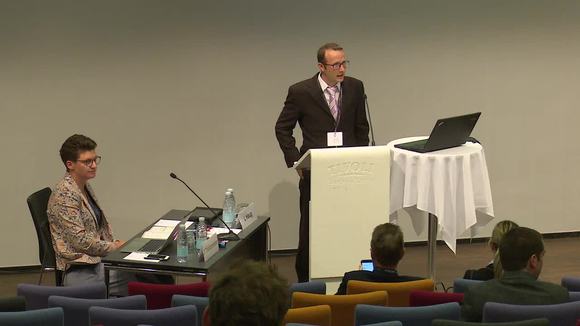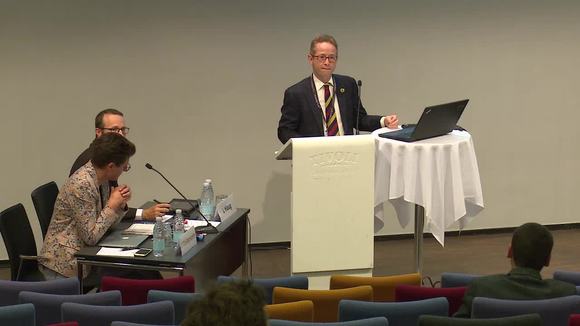Player is loading...
A-0792 Interobserver Reliability Study of the Classification of Scaphoid Waist Fractures using Computer-Tomography
Rasmus Wejnold Jørgensen, Anders Klahn, Johannes Heindl, Lars Solgård, Lars Vadstrup, Dejan Susic, Robert Gvozdenovic, Stig Jørring, Claus Hjorth Jensen, Hand Clinic, Department of Orthopedics, Herlev-Gentofte University Hospital of Copenhagen, Denmark
Friday, June 15, 2018 · 2:23 p.m. · 05m 43s
Embed
Embed code is not allowed
This talk is part of a Private webcast, embeding is not permited.Transcriptions
Note: this content has been automatically generated.
00:00:00
okay thank you for the introduction
00:00:05
so the background of the study is that we think uh that conventional radio grass are
00:00:10
uh unreliable and insufficient in the classification of skateboard a weight factors
00:00:16
and uh the the choice of treatment uh of these uh uh regress
00:00:21
uh computes marker fee has been playing to be the
00:00:24
tool of choice when determining factor displacement and uh
00:00:28
fact a displacement this uh maybe one of the most important factor is uh in fact revealing
00:00:35
so the purpose of the study is to determine the inter rater reliability and
00:00:39
integrated beep visibility in the classification and that the
00:00:43
choice of treatment in a skip always fractures
00:00:47
the rate of population uh consisted out of the of the peak surgeons with
00:00:51
a particular interest in hand surgery they're all working at our department
00:00:57
so we had fifty one scapegoat way factors with c. t. scans
00:01:02
and a seven independent of the p. d. surgeons uh they look at all the scans
00:01:07
they classified each factor in uh on this place fractures list into millimetre displacement or more
00:01:12
than two millimetre displacement and they suggested the treatment of a four weeks remotely station
00:01:18
uh maybe a controversial but uh four weeks a mobile station
00:01:21
eight to twelve weeks mobile station and uh operation
00:01:26
this could be a simplified just to look at the the factors that was
00:01:31
a classified less than two millimetre displays the more than two millimetre
00:01:34
and uh uh the factors that were uh suggested to be treated
00:01:38
non operative lee or uh with o. production so fixation
00:01:44
so based on the first round of classification we were able
00:01:47
to calculate the inter rater reliability meaning how well each
00:01:51
surgeon agree with each other and uh we did this both for the classification and the choice of treatment
00:01:59
based on the second round classification we uh we
00:02:02
could calculate the integrated reproduce ability meaning how
00:02:06
well each surgeon agreed with themself both for the classification and that the choice of treatment
00:02:13
and uh these uh demographics are base that on the first round of uh
00:02:18
uh both uh classification and and treatment and we see that uh about
00:02:23
thirty eight percent of the the fractures or classified as on displaced
00:02:27
forty percent more than or less than a two millimetre displaced
00:02:31
and the twenty percent a modern term limits placed
00:02:35
for the treatment uh about eighty percent or suggest it should be
00:02:38
treated conservatively and uh about twenty percent uh uh operate
00:02:45
and so for the inter rater reliability how well the the surgeons
00:02:49
agree with each other uh we calculate the kappa value
00:02:53
and uh the kappa value was interpreted or translated by land dissing cock a distracted agreement
00:02:59
and uh when you have the the three different uh classification groups and displaced a less than two millimetre all
00:03:06
more than two minute display structures the kappa value was a point five to translate to moderate agreement
00:03:13
when you simplify the classification system you get an increase in the kappa
00:03:17
value which is expected and it just met a substantial criteria
00:03:23
uh in choosing the treatment that we saw a a fairly low kappa value
00:03:28
of a point three uh eight uh um translated to just fair agreement
00:03:34
but when a simplifying the the choice of treatment to the casting versus
00:03:39
open adoption some fixation the kappa value increased as we
00:03:42
expected and uh then it's worse moderate agreement
00:03:48
so looking at the incinerator reproduce ability so the looking at
00:03:53
how well each surgeon agreed with themselves what they said
00:03:56
one week earlier um we saw substantial agreement on all parameters and
00:04:01
increasing kappa values when simplifying both the classification system nor the choice of treatment
00:04:10
so in conclusion to this uh that was substantially inter rater reliability when uh in in
00:04:16
classification between last into media displays the fractures and more than two millimetre space lectures
00:04:22
uh but only moderate inter rater reliability when choosing between an operative treatment or operative treatment
00:04:29
the inter rater rip disability was a substantial the agreement on all parameters
00:04:35
uh and uh both both for the classification and the choice of treatment
00:04:40
so in the future we recommend for the training of surgeons before we will introduce the
00:04:45
routine of c. c. both for the classification fractures and and the choice of treatment
00:04:51
thank you much how
00:05:00
are there any questions
00:05:06
well you said you had that i'm surgeons and have you looked at
00:05:11
different as well so are there you are working right more experience
00:05:17
but we yeah we we try to look at this uh um there were some surgeons with a lot of experience and
00:05:24
younger surgeons with less experience and we didn't uh uh like an
00:05:29
over test for to see if if any of the surgeons
00:05:33
did better or worse than the other and there were no different the twenty surgeons
Conference Program
A-1233 What do we expect from FESSH
Luzian Haug, Bern, Switzerland
June 15, 2018 · 1:59 p.m.
A-1233 What do we expect from FESSH - Q&A
Luzian Haug, Bern, Switzerland
June 15, 2018 · 2:04 p.m.
A-1240 How to get your paper published
Grey Giddins , UK
June 15, 2018 · 2:05 p.m.
124 views
A-1240 How to get your paper published - Q&A
Grey Giddins , UK
June 15, 2018 · 2:22 p.m.
A-0792 Interobserver Reliability Study of the Classification of Scaphoid Waist Fractures using Computer-Tomography
Rasmus Wejnold Jørgensen, Anders Klahn, Johannes Heindl, Lars Solgård, Lars Vadstrup, Dejan Susic, Robert Gvozdenovic, Stig Jørring, Claus Hjorth Jensen, Hand Clinic, Department of Orthopedics, Herlev-Gentofte University Hospital of Copenhagen, Denmark
June 15, 2018 · 2:23 p.m.
A-0237 Neuropathic pain after repair of brachial plexus injury : a 30-year follow-up of the Narakas' series
Swenn Maxence Krähenbühl, Chantal Bonnard, Laurent Wehrli, Lausanne University Hospital, Lausanne, Switzerland
June 15, 2018 · 2:29 p.m.
A-0482 Pisiform Excision; a solution for a long-term ulnar sided wrist pain. A retrospective analysis, comparing pre- and postoperative measurements
M.V. van Burink, S. Al Shaer, J. van Rossen, A. Fink, H. Slijper, T. M. Moojen, H. Rakhorst, G. van Couwelaar, R. Feitz, O.T. Zöphel, Xpert Clinic, The Netherlands
June 15, 2018 · 2:35 p.m.
2024 views
A-1075 Extensor tendons adhesions: the role of different anti-adherent agents. Preliminary evidences from an Italian multicentric study.
Alfio L Costa, University of Messina, Department of Human Pathology of the Adult, the Child and the Adolescent, Messina, Italy
June 15, 2018 · 2:42 p.m.
A-0328 Prevalence of the Linburg–Comstock Anomaly in Women with Carpal Tunnel Syndrome
Saulo Rodrigues Moreira, Carlos Henrique Fernandes, Lia Myamoto Meirelles, Luis Renato Nakachima, João Baptista Gomes dos Santos, Flavio Fallopa, Hospital São Paulo/Universidade Federal de São Paulo/ Department of Orthopedic Surgery/ Hand Surgery Unit, Brazil
June 15, 2018 · 2:51 p.m.
112 views















